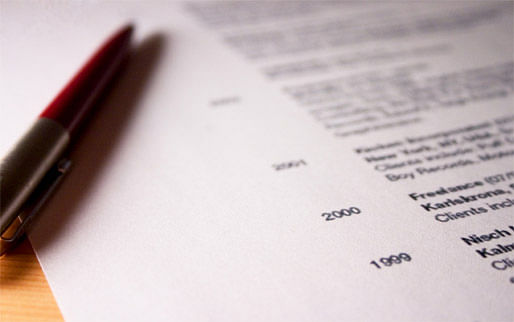

by James Long/Ellicott Long
Finding your first architecture or design job can be a daunting experience. It is the culmination of all those years of hard work and study and the chance to go and get some real experience in the industry. Throughout my time recruiting within the design profession I have seen a lot of graduate level CV’s and design portfolios and I have met a lot of candidates looking to take that first step into a design firm. This article hopes to provide some useful guidance on how to maximise your chances of success in securing that initial role and draws on examples that I have myself experienced both in the UK and Asia.
As there is quite a lot to focus on so this guide will be published in 3 parts:

Writing Your CV
There are numerous articles and sites giving advice on how to write a CV. Most are tailored for those with a number of years experience working for companies and there are very few guiding graduates in the design industry. Graduate CV’s however will not generally have work experience to add so it’s important to highlight other areas.
Firstly, it’s worthwhile creating a graphical CV. This should be something which visually shows some of your creativity whilst also ensuring that you include as much information about yourself as possible.
Focusing on the visual side, I’d recommend being creative but subtle. Often, graduate CV’s will try to counteract a lack of practical work experience by overloading the pages with images, colourful flourishes and a visual barrage. Be careful here, it’s important to have a balance which gives just enough of a flavour of your design skills but also allows for the written information to be easily accessible and not hidden in a mass of drawings. I recommend that you start out by using a common CV structure and then add creative touches around the written content to complement the content i.e. start with a simple written CV and then design around that. I shall therefore outline the structure and written content that I think you should include.
Start with your personal information, full name (English and other language), contact details etc. A photo is not necessary but sometimes asked for by companies – this is a matter of personal taste. If you use one, please ensure it is not too artistic or fanciful, a simple portrait image, about the size of a passport picture should suffice. I have seen some extreme examples but none more so than the hopeful graduate who sent a CV which had a photo of him in a chicken hat and funny glasses…a talking point perhaps, an aid to him finding work? Perhaps not!
Following on from your personal information, it’s worth writing a brief personal profile. Outline your strengths, skills and any experience you may have. Also highlight your personal characteristics and any aspirations. Be slightly careful on the aspirations – highlighting “a desire to work with a big name architect” only to send your CV to a small studio can send conflicting messages. Therefore do not be afraid to tailor the profile to suit the application you are making and make sure you keep track of the CV’s you send to different companies. Also mention any significant languages spoken.
Next you should outline your education. This should detail your years of study both as undergraduate and postgraduate, the institutions and grades achieved (expected). Briefly outline your significant projects and grades here – you will go into more detail on these shortly. There is no need to list all your school grades/exams – simply provide an overview. e.g. 11 GCSE’s grade A-C. You should also include any awards/medals you received during your studies here – you can go into more detail on them in the following parts.
I would now recommend highlighting your university project experience in a bit more detail. As most experienced design CV’s will take the time to highlight professional projects undertaken, so should a graduate’s CV focus on the projects completed, albeit at university. Include both individual projects and those completed as part of a team. This should only include your significant projects and does not need to include a 1 week design study (unless of course it’s extremely relevant). Outline the project brief, your approach, how the design developed and the end result, including any grades/awards. If working as a team, highlight your contribution to the project specifically. This may be the part of your CV where you include some sample images – remember be subtle and relevant. You don’t need hundreds, save that for the portfolio.
Following on from your university experience, I would now outline any practical RELEVANT work experience (paid or otherwise). In that I mean include any design work you have done for a company but not necessarily the bar work you did whilst on a gap year in the Andes! This should include your dates of employment, the company, your position and an outline of your role. A brief project breakdown is good to add – make sure you outline what you did specifically on these projects, even if it was detailing toilets. Don’t worry if you haven’t got lots to add to this section – simply focus on adding more to your academic project/practical experience.
Following your work experience, it’s time to detail other specific skills. For example your CAD competency, IT knowledge, hand drawing ability etc. Outline each software package you can use including a level of proficiency for each. A lot of firms are looking for new package experience with the likes of Rhino, Maya and Revit being of particular interest – do make sure you include any specialist software here but equally be honest about your proficiency. Also, do say if you are strong at hand drawing and add them to your portfolio for interview. This is the section to outline your language proficiency – if you are only English speaking it is not necessary to have this as a skill (it should be obvious by the CV you have written!) but do include any other languages you speak at a decent level of proficiency, indicating the level of proficiency.
Finally it’s time to talk about your interests or any other relevant information. Here you should include things such as team membership at university, any leadership positions you have had or extra-curricular activities undertaken. Mention if you have been travelling but obviously you don’t need to include all your holidays!
You can include reference information here if you wish. As a graduate this is normally a university tutor/s and any work experience referees.
The information above should form the written basis of your CV and as a graduate should probably be around 1 ½ pages to 2 pages long. It does not need to be any longer than this. Once this written basis is complete, you can add the graphics which give it your creative touch and allow the person reviewing it to get a feel for how you present your work. If you plan to email your CV to companies then perhaps add some additional sample images in the form of a sample portfolio to the end of the CV – please do be careful with the file size though as most firms have a limit on the email attachment size that they can receive.

Writing a Cover Letter
Once you have written your CV it is important to also write a cover letter to include with any applications you make. This guide will help you put together a generic standard format cover letter but for reasons I will outline later, you should ensure you personalise each letter you send out.
Firstly, a cover letter should be addressed to someone. Taking the time to find out who the right point of contact is at a company, their position and a bit of background information can make a big difference. A generic “To Whom It May Concern” or a “Dear Sir/Madam” can show that the letter is generic and non-specific. I will go into more detail about submitting your applications in Part 2 of this article, Applying For Positions.
Next you should express your interest in their company (name the company) and if relevant, refer to the advertised position you are applying for, including any reference number. This again personalises your cover letter.
The next stage is to write a brief outline of your current status. i.e. you are a recent graduate looking to take on their first position in a leading….etc. You should also write a brief background which should not just be a carbon copy of your CV profile. Again, depending on who you apply to, this should be tailored to the target company. For example, if you have some experience working on a high-rise project and the company you are applying to has a high-rise specialism, make sure you include this. Less relevant would be to apply to this company saying you have experience in transport schemes. Just try to tailor your experience to the company you are applying to. It shows you have done your research.
Next highlight (briefly) the key skills and achievements from your CV. This could be a description of any awards you have won and should also include your language proficiency if applicable.
That’s it! It should be fairly short, to the point and relevant to the company you are submitting the information to. You can construct a standard format and tweak a couple of sentences here and there to fit each application.
End the letter with something positive along the lines of “I look forward to hearing from you” or “I welcome the opportunity to interview with you to discuss my experience in detail” and close the letter with “Yours sincerely” if you find the name of the person to contact or “Yours faithfully” if you don’t.
In Part 2 I will give advice on putting together a portfolio and actually applying to positions. Part 3 will focus on interviewing successfully as a graduate and how to handle the offer.
1 Comment
Great post!
Block this user
Are you sure you want to block this user and hide all related comments throughout the site?
Archinect
This is your first comment on Archinect. Your comment will be visible once approved.